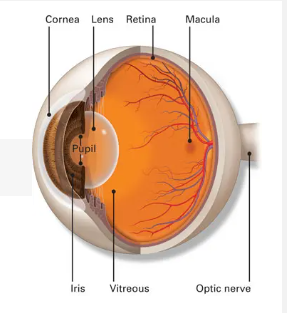Your retina has 2 main areas: the macula and the peripheral retina. The macula is responsible for central vision and fine details, whereas the peripheral retina allows you to see peripherally. For example, if you were to look at someone sitting across the table from you, your macula allows you to see their face while your peripheral retina allows you to see the rest of the room.
In order for your macula to work properly, it must lay flat against the back of the eye. See the diagram below:

As you get older, the vitreous (the gel-like material between the macula and the lens) can shrink and pull away from the retina. This starts as early as your 40s and is common for most people by the time they reach age 70; however, in some cases, the vitreous can stick to the macula and begin to pull on it. The separation and pulling of the macula can lead to scar tissue formation, which can cause the macula to wrinkle or bulge. These wrinkles or bulges are referred to as macular puckers or epiretinal membranes.
Epiretinal membranes will not affect your peripheral vision but can lead to distorted, wavy central vision. You may also notice that your central vision is cloudy or gray; in some cases, you could notice a blank area in your central vision.
Aging is the #1 risk factor; however, those with previous retina detachments, retinal blood vessel issues, or eye trauma are also considered at-risk. Treatment depends on the severity of the symptoms. For mild symptoms, your ophthalmologist might recommend only monitoring. In more serious cases, a vitrectomy surgery might be recommended.
The retinal specialists at Fort Lauderdale Eye Institute – Dr. Burgess, Dr. Lara, and Dr. Villate – are highly-skilled at dealing with retinal problems like an epiretinal membrane. If you are currently experiencing central vision issues or symptoms similar to those described above, call our office at 954-741-5555 to schedule a consultation with our retinal specialists.






